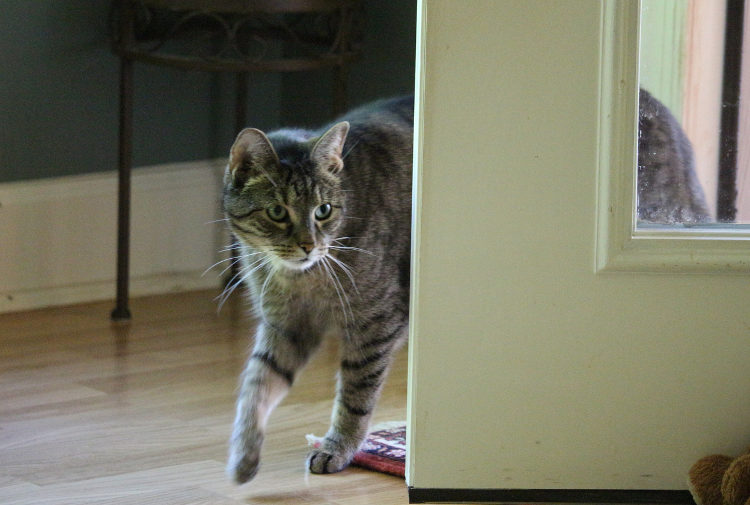In 2011, a 4-year-old tortoiseshell cat named Holly became separated from her owners, who were traveling by RV in Daytona, Florida. Despite being nearly 200 miles from her home in West Palm Beach, she was able over a period of two months to make her way back. That same year, George, a one-eyed orange tabby, escaped his veterinarian’s office and made the 5-mile, 10-day trek home through traffic and heavy snow.
You hear these stories all the time. In fact, one of my favorite childhood books—The Incredible Journey, featuring a siamese cat and her two dog friends making their way home—became popular movies the featured cat’s unique homing instinct.
When I was 18, my cat Spike—the most zen cat in the world, whom I adopted from a shelter the day he was scheduled for the big sleep—fell out my third floor window and disappeared. Worse? We had to leave immediately for my grandfather’s funeral. Even worse than that? We’d only lived in Philadelphia for a few weeks when he fell. Well aware of the cat’s remarkable homing instinct (I was a huge fan of the book The Incredible Journey as a kid) I was so worried that he’d headed back to Michigan. But two days later when we got home, there he was: thirsty and hungry but alive and well. I guess his homing instinct had reset.
So how exactly do cats find their way home?
It turns out that the literature is rather scant in this area—one of the most detailed experiments coming from Francis Herrick, who published his findings in Homing Powers of the Cat in 1922. Herrick’s method was simple, though incredibly cruel. He took a female cat that had a litter of nursing kittens at home and transported her alone in a sack to several remote locations (something that makes my brain EXPLODE), where he then released her. In 7 of 8 trials, she returned home. After the eighth, at a distance of 16.4 miles, she did not. Herrick looked at the way the cat made her way back each of the 7 successful trials and noted that she always headed in the correct direction after only a moment’s deliberation.
In 1954, German investigators Precht and Lindenlaub removed cats from their homes placed them in a maze with several exits. Over 60% of the time the lost cats chose the exit facing the direction of their home. In 1977, in The Cat: History, Biology, and Behavior, Beadle theorized that cats, like homing birds, are extremely sensitive to the geo-magnetic fields that surround the earth. This sensitivity, he postulated, gave them an unusual ability to geolocate.
Animal Wellness Magazine cites some more current perspectives. For example, animal behaviorist Alice Moon-Fanelli, PhD, CAAB, points out that cats practice their geolocating ability when they are out in the environment—a feral or outdoor cat who is accustomed to finding its way around will likely be more practiced and less “clueless” than a cat that has spent its entire life indoors.
Russell Hartstein, CDBC, CPDT, proposes that a cat’s homing ability is the result of combined factors—such as smell and sensitivity to magnetic fields. He goes on to say that there may even be a sort of directional sensitivity at the sub-molecular or even subatomic level—as when separated electrons orient the direction of their spin even when no longer in close proximity to one another.
Of course, not every lost cat returns home
Investigators seem to feel this is due to accidents, obstacles, and other confounding factors, rather than to a failure in the cat’s geolocating ability. The health and emotional state of the cat also seem to play a role. An injured, panicked, or severely malnourished animal may not be physically capable of making the journey or may become confused along the way. Yet it can’t be denied that lost cats have an amazing ability to know where home is.
So what can you do if you and your cat become separated?
Here are a few simple tips we hope will help.
• Make it easy to identify your cat, either with a collar tag or microchip. That way you’ll be contacted should a Good Samaritan locate your pet.
• Leave out some food and water at home. If your cat has no tag or chip, it may still be trying to reach home. It will likely be hungry and dehydrated when it gets there. Also the smell of food will help direct it once it gets within sniffing distance.
• Call local vets, both where you are and in your home area. Alter vets to your lost animal. In the unfortunate case of an accident, someone may bring your cat to a local vet for treatment.
• Post on online “Missing Pets” message forums and bulletin boards. The more eyes there are looking for your cat, the more likely you are to have a happy reunion.






